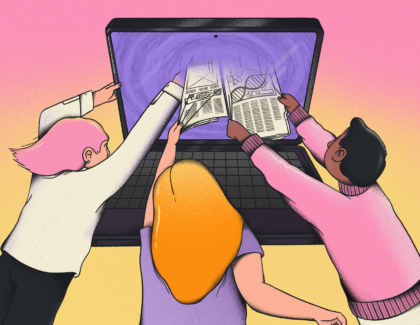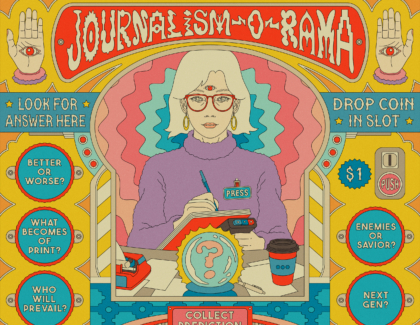Sign up for the daily CJR newsletter.
On April 22, 2023, Gerry Flynn was in the Chhaeb-Preah Roka Wildlife Sanctuary in Cambodia, filming an interview with a local forest activist. Then came a sound that set the activist off running. “One minute we are sitting around,” Flynn recalled, “the next there are guys in uniforms with guns on their back, on motorbikes, demanding that we all leave.” Flynn, who is thirty-three and from the United Kingdom, had been working out of Phnom Penh, the country’s capital, for Mongabay, a nonprofit international outlet focused on conservation news. The guys on motorbikes were from Cambodia’s Ministry of Environment Rangers—a corrupt operation, according to a report from Amnesty International, known for its intimidation of environmentalists and Indigenous groups. “I think you see this across Southeast Asia,” Flynn said, “where there are more tightly controlled media landscapes, a lot more repression, a lot more censorship, a lot less space for criticism and critical reporting.”
Flynn—along with a photographer, a local journalist, and their sources—suddenly found themselves subject to arrest and imprisonment for illegally entering a protected zone. From the back of a ranger’s truck, he managed to access a patch of 4G and send a message to a group chat that included his editor and a Cambodian human rights organization. The organization saw the message, then quickly called the United Nations, which contacted the British embassy, which reached out to local authorities, telling them to drop the case. “By the time that we were out of the jungle, the rangers had been given orders to let us go,” Flynn said. “With almost every story that we get out, readers—here or around the world—say, ‘Great job, how are you able to get away with this?’”
To Rhett Butler, the founder and CEO of Mongabay, the answer comes down to being proactive. When vetting a story in a high-risk area—common, especially for the site’s investigative pieces—editors will request paperwork for risk assessment and travel, which is shared with a safety committee composed of sixteen members of the staff, mostly editors, with varied regional expertise, as Mongabay has a wide international presence. The committee then comes up with a list of reporting requirements that might include satellite phones, wireless routers, GPS tracking, and a detailed itinerary. The publication reports in six languages, from bureaus around the world, in coverage that appears on Mongabay-Global, an English site, as well as on Mongabay-Indonesia, Mongabay-Latam, Mongabay-India, Mongabay–India Hindi, Mongabay-Brasil, and Mongabay-Africa. The editors rarely say no to a story. It’s usually a matter not of if, but how.
That is Butler’s way. He is forty-six, and used to work in tech in Silicon Valley; he started Mongabay as a passion project from the HTML up as a one-person blog in 1999. He grew it, during the Yahoo-search and Google AdSense days, with a small following and turning a profit, by publishing everything from World Wildlife Fund press releases to environmental studies. As online conditions changed, he adapted. “Around 2010,we lost like three or four million visits a month, because essentially people had no reason to go to websites anymore,” he said. The following year, Butler ditched the ad dollars and transitioned to a nonprofit model. “I had a lot of ideas I wanted to pursue.” It was then that he received a grant to fund a Bahasa Indonesian–language bureau, which became the first of Mongabay’s regional sites. “It’s always an iterative approach,” he said. “Trying things out to learn what’s working or what’s not and then modifying in response to that.”
These days, the organization employs more than a hundred staff members in some thirty countries and works consistently with more than a thousand freelance local journalists; collectively, the sites see more than six million views per month. There is no physical headquarters; the operation runs on virtual meetings. Some of the big-name funders on Mongabay’s annual reports include the Ford Foundation, Rockefeller Philanthropy Advisers, the Climate and Land Use Alliance, and the Walton Family Foundation. But the list is long—no one donor makes up more than 9 percent of Mongabay’s revenue. “It gives me the power to walk away from any grant or say no to any funder, which I think is really important,” Butler said. “I’ve seen a lot of media outlets not make it because they’d gotten a windfall grant and come to rely on it. I don’t assume that any funder is going to continue supporting us.”
The focus of the coverage is impact. After reporters exposed the potential harms of a new hydroelectric dam in Cameroon, international financial partners, including the World Bank, provided some compensation for the community. When Mongabay wrote about an oil company in Brazil that persuaded Indigenous communities to sign documents outside of international conventions, the country’s federal prosecutor investigated damages and violations to those groups. Since 2023, coverage has become explicitly solutions-oriented, including suggestions to policymakers on how to address problems described in a piece; the same year, Mongabay debuted a data studio, featuring numbers-driven stories and visualization tools—including satellite imagery overlaid with environmental and social data, fire weather charts, and an interactive global trade flow map—that any environmental journalist can use. There is also a site geared toward kids under the age of twelve, providing “news and inspiration from nature’s front line.” Some coverage takes multiple forms: the outcome of Flynn’s reporting last year included a feature story, a “Chasing Deforestation” video series, as well as a sixty-second explainer for social media, designed to maximize reach. According to a funder’s review, Butler said, 73 percent of the articles Mongabay published in the past year were stories that had otherwise gone unreported: “No one would have known about it if we didn’t publish it.”
The decentralized nature of the operation can pose challenges—for one, writers are paid according to a complicated wage structure, informed by local costs and inflation rates. There has been tension in the past, negotiating fair contracts; for the most part, Butler has left decisions up to the leadership of regional bureaus, but after hearing complaints, he initiated an annual process to personally review pay equity. The greatest concerns among Mongabay’s leadership are the safety of local reporters, especially freelancers, and the impact of their coverage on sources. “They can’t just leave after a story comes out,” Butler said. All local journalists and sources are given the option of anonymity.
According to a recent UNESCO report, 70 percent of environmental journalists are attacked for their work—targeted with arrest, online harassment, legal attacks, physical violence, and murder. “It’s not sustainable,” Nehru Pry, a freelance Cambodian journalist and filmmaker who often works with Flynn, told me, “though Mongabay has done a lot.” Mongabay doesn’t publish in Khmer, the Cambodian national language, but Pry said that local outlets will occasionally pick up the site’s stories and translate them; often, he will decline a byline in order to protect himself. Recently, he and Flynn reported on another local journalist who had been covering deforestation for a local outlet—and was charged for the very crime he was reporting about. The journalist received anonymous threats. “They burnt his house. They called him and said they’re going to kill him,” Pry said. “There’s a lot of bad things happening here, and we are the ones who talk about it.”
After Flynn and his colleagues made their narrow escape from the Chhaeb-Preah Roka sanctuary, Mongabay updated its security protocols. Editors now require at least two members of staff to be on a group chat in order to avoid time-zone-related delays, and that reporters on remote assignments carry a company-issued router. In a follow-up story this past October, Flynn exposed that the area’s protected wood may be supplying floor manufacturers in the United States. (The US companies denied that.) Flynn said that there have been no consequences from the reporting yet, but that in Cambodia, it’s typical to be met with a collective shrug from officials. “I know lots of journalists working elsewhere, even in some other parts of Southeast Asia, who enjoy good working relationships with governments or who actually get help from government institutions when it comes to reporting,” Flynn said. “But those sorts of things are a bit of a pipe dream out here in Cambodia.” Mongabay is staying on it anyway.
Has America ever needed a media defender more than now? Help us by joining CJR today.







